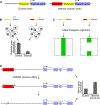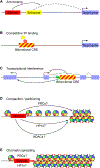Transcriptional Silencers: Driving Gene Expression with the Brakes On
- PMID: 33712326
- PMCID: PMC8119328
- DOI: 10.1016/j.tig.2021.02.002
Transcriptional Silencers: Driving Gene Expression with the Brakes On
Abstract
Silencers are regulatory DNA elements that reduce transcription from their target promoters; they are the repressive counterparts of enhancers. Although discovered decades ago, and despite evidence of their importance in development and disease, silencers have been much less studied than enhancers. Recently, however, a series of papers have reported systematic studies of silencers in various model systems. Silencers are often bifunctional regulatory elements that can also act as enhancers, depending on cellular context, and are enriched for expression quantitative trait loci (eQTLs) and disease-associated variants. There is not yet evidence of a 'silencer chromatin signature', in the distribution of histone modifications or associated proteins, that is common to all silencers; instead, silencers may fall into various subclasses, acting by distinct (and possibly overlapping) mechanisms.
Keywords: chromatin; repression; silencer; transcriptional gene regulation.
Copyright © 2021 Elsevier Ltd. All rights reserved.
Conflict of interest statement
Declaration of Interests There are no interests to declare.
Figures



References
-
- Shlyueva D et al. Transcriptional enhancers: from properties to genome-wide predictions. Nat Rev Genet. 2014; 15, 272–86. - PubMed
-
- Davidson E (2001) Genomic Regulatory Systems: Development and Evolution, Academic Press.
-
- Spitz F and Furlong EE Transcription factors: from enhancer binding to developmental control. Nat Rev Genet. 2012; 13, 613–26. - PubMed
Publication types
MeSH terms
Substances
Grants and funding
LinkOut - more resources
Full Text Sources
Other Literature Sources

